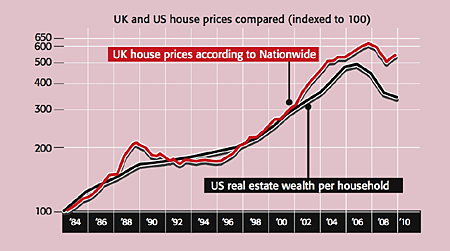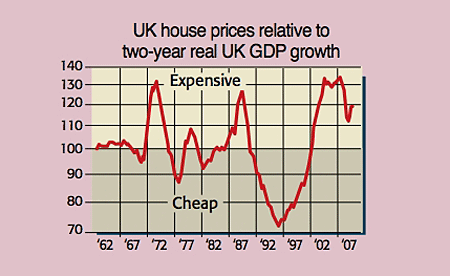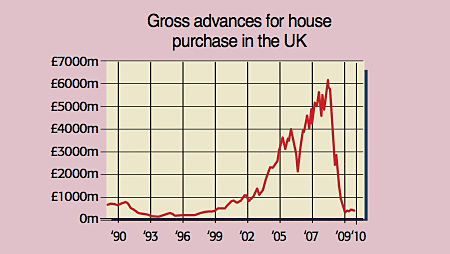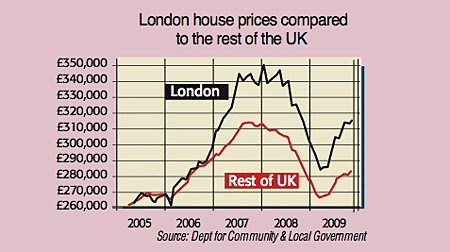Don't be fooled - house prices will fall again
One year on from Britain's property slump, and house prices seem to have staged a dramatic rebound. Some areas have even hit new all-time highs. So what's going on, and what happens next? James Ferguson explains.
It's been five years since I first warned MoneyWeek readers that Anglo-Saxon property prices in general, and British ones in particular, were getting too high. Almost four years ago, the US Case-Shiller 20-city home price index peaked. Then 18 months later, in late 2007, British house prices reached their zenith.
The housing bubble didn't burst in isolation. Subprime mortgage-backed securities all but took out the US banking system. In Britain, aggressive lending and lax standards knocked down banks like nine-pins. Failing banks led to imploding credit, which resulted in further house-price falls, as mortgages became impossible to come by. American bank lending has been falling steadily now since November 2008. By the end of 2009 it was down a staggering 7.2% year-on-year. The sharpest post-War contraction in bank lending before this was the 1% annual drop seen in September 1975. So this is truly historic stuff. It's perhaps not surprising that American house prices are already 30% off their 2006 peak.
Japan's experience shows just how bad a credit famine can get after a banking crisis. Surviving banks struggle to stay solvent as they realise losses dating from the credit bubble. In August, it'll be the 20th anniversary of the peak in Japan's six major cities' residential land index. In that time, barring a brief uptick between 2006 and 2008, prime urban housing land has lost two-thirds of its value. Banks, credit, economic growth and house prices are closely tied to one another or so it seems.
MoneyWeek
Subscribe to MoneyWeek today and get your first six magazine issues absolutely FREE

Sign up to Money Morning
Don't miss the latest investment and personal finances news, market analysis, plus money-saving tips with our free twice-daily newsletter
Don't miss the latest investment and personal finances news, market analysis, plus money-saving tips with our free twice-daily newsletter
Why has Britain been spared?
But the UK has followed a very different path. At first things went according to the model. House prices peaked. Foreign lenders pulled out of the market, as did mortgage intermediaries who relied on access to cheap funding in the wholesale markets. The number of domestic mortgage writers shrank as one after another they were sold or nationalised. Between late 2007 and early 2009, by most measures, British house prices fell around 20% (see the main chart). That's what the Japanese or the Americans would call a good start.

But one year on and house prices have staged a dramatic rebound. Most indices show that prices outside London are almost 10% higher. London prices are up by even more. One agent's index of prime central London houses suggests that prices were at a new all-time high by the end of December. What's more, they added a third to their value in the final quarter alone. That's a faster growth rate than at any time since the housing bubble began. What's going on?
American mortgages cost more
The first thing to appreciate is that unlike the US, British mortgage rates tend to be short-dated. People rarely fix for more than five years. In America, a heavily subsidised (and now largely nationalised) mortgage insurance market has given rise to 30-year fixed-rate loans, with downward-only resets (in other words, the rate can only fall). As such, American mortgages are determined by the yield on the long bond (the 30-year US Treasury), whereas British mortgagee rates are derived from the Bank of England base rate.
This is handy for UK policy-makers. Base rates can be cut rapidly when the economy turns down. The resulting fall in mortgage payments boosts the average household's disposable income, which in turn supports consumer demand. The downside is that as soon as the recovery takes hold, particularly if inflation kicks off, the Bank looks to hike rates, often quite sharply. In 1973, 1978 and 1989, mortgage payments doubled in the space of 12 months, bankrupting many people.
This option isn't open to the American authorities. Because mortgage rates there are based off the long-bond yield, they have only fallen from a 2007 peak of 6.8% to 5% now. Even this fall has been largely due to the US version of quantitative easing (QE, or money printing). The Federal Reserve has bought huge amounts of residential mortgage-backed securities (RMBS), both to pump money into the system and to force mortgage payments lower. So now, helped by the nearly one-third drop in home prices, US affordability is back to its old highs. This suggests that once the excess supply hitting the market, due to foreclosures (what we'd call repossessions), is absorbed, house prices can carve out a genuine long-term floor.
We can't put off the pain forever
By contrast, in Britain we've had no need to clear any repossession overhang, nor to push prices down, nor manufacture any economic recovery to ride back out on. We've just cut rates like they've never been cut before. Before 2008, the lowest UK base rates had fallen in the previous 60 years was 3%. The lowest mortgage rates got was 2% above that, at 5%. But a year ago all that changed. The Bank cut base rates from 5% to 0.5% and they've been there ever since.
Just how long this can last is anyone's guess. The irony is that if the bulls are right (and I'm guessing they're the ones buying houses right now), the economy will recover very soon. That would mean that inflation is a real risk and rates have to rise before prices run out of control. Based on sterling weakness and oil-price volatility alone, the annual rate of headline Consumer Price Index (CPI) inflation could well top 3.5% before Easter. Over the last 20 years, the base rate has on average been around four percentage points above headline CPI. So let's say CPI settles around its current 2.9%. That means base rates 'should' be 6.9% and mortgage rates 2% above that at 8.9% double the current standard variable rate (SVR). How many house-price bulls have figured that into their 'return to normalcy' scenario?
Now, I don't think that's how this will pan out. I subscribe to the far gloomier view that we'll get a double-dip recession as fiscal policy is tightened. This will result in deflation and interest rates staying low for ages. But wouldn't this keep mortgage rates low and be good for house prices? Sadly not. Rates will only stay low if the recovery falters, credit remains constrained, taxes rise, bonuses and government spending get cut, and unemployment rises. None of these is good for housing demand and, in fact, several will result in more distressed sales.
It's a classic Catch-22. If the economy recovers and things normalise, mortgage rates will rapidly double, snuffing out any house-price growth and most likely kicking off the second stage of the down-leg. On the other hand, if the economy keeps struggling, then although rates will stay low, the demand and particularly the supply situation will get much worse.
Banks don't want to lend
Historically, non-performing loans (NPL) in post-crisis banking systems reach an average of 25% of the total loans written. And you usually see a significantly worse recovery rate than normal, at around 60% (in other words, the bank claws back a typical 60p in the £1 from these bad loans). These two factors generate a total loss rate of 10%. But it can get a lot worse. Japan suffered 35% NPLs and an average 40% recovery rate, so losses there have now exceeded 20% of total loans.
More onUK PropertyWhy estate agents need house prices to fallTwo steps towards solving the housing 'crisis'
Given how geared banks are (even at the best of times capital is rarely more than 4% of total assets), such loss rates wipe out capital several times over. Replacing that capital through retained earnings when net interest margins (NIM) are in the 2%-3% range can take years. For that whole time, banks are forced to hide the true extent of balance sheet losses.
Crucially, banks know themselves how bad things are and so are loath to expand loans and other risk assets. So shrinking lending is the number one piece of evidence to show that, whatever they may say in public, banks are technically insolvent and repairing their broken balance sheets. So has loan growth been shrinking? Well, British banks' loans to UK residents peaked in November 2008. Since then, lending has been shrinking, but not by very much. The collapse in UK mortgage approvals was in fact caused by overseas-based banks pulling out of the UK mortgage market. But this doesn't mean that British banks aren't savagely cutting lending they're just far too savvy to inflict the pain here, on the very taxpayers who bailed them out.
Just as foreign bank lending to British homebuyers evaporated after the bank crisis struck, British banks' lending to foreigners (adjusted for exchange rate movements) has shrunk over the last year by 17%, or £89bn. That's equivalent to 6.4% of UK GDP.
If banks are shrinking their loan books, that means two things. First, borrowing in general will be tight. So assets (such as houses) that rely on credit to support their value are likely to struggle. Second, it means banks need to repair their balance sheets. It's quite normal for bank lending to level off at zero in deep recessions as banks refuse to make new loans. But it's quite another matter when you see banks contract credit, effectively demanding that loans be repaid. That means balance sheet repair. This typically takes at least five years so far we're only 15 months in.
Tight credit bodes ill for the private sector. Recessions usually end because easy credit conditions boost the spending power of households lucky enough to still be in employment. Rising demand for goods such as houses, cars and furniture starts to suck the unemployed back into the workforce, and with more people in jobs, demand keeps growing. But without credit growth, this whole cycle can't start.
Banks who need to shrink risky loans obviously want to make new borrowing as unappealing as possible. So, for example, even though base rates have dropped by 90%, credit card rates are as high as at any time since the crisis began. Spreads (the difference between the base rate and what banks will lend at) are now at a record. Overdraft rates now average 19%, a full 5% higher than when the crisis struck.
Meanwhile, 90% loan-to-value (LTV) mortgage rates are now so rare that the official statistics have stopped noting them. However, a recent Nationwide two-year fix best-buy rate was 5.98%, plus a £1,000 fee that effectively takes the rate to 6.5% for the average home. That's the same as two-year fixes cost three years ago, when the base rate was ten times higher than it is now.

Special FREE report from MoneyWeek magazine: When will house prices bottom out - and how will you know?
- Why UK property prices are going to fall 50%
- When it will be time to get back in and buy up half price property
Repossessions are set to rise
Another thing that we haven't yet seen in Britain is the normal recessionary forced selling of property. Super-low mortgage rates have bailed some out for now, but mostly it's been the government's fiscal policy that has held sellers off the market. Unparalleled spending has kept the economy at a higher level than it would have slumped to, while electioneering has prevented Gordon Brown from cutting the public sector payroll. Yet all this misery is still to come. You can't pick up a paper today without seeing Greece's woes all over it. There but for an upcoming election go we.
Post election, the job cuts across the public sector will have to be extensive. The end of QE, further spending cuts and an increase in income tax will all mean slower growth. Whether this results in a double-dip recession will depend on the timing and scale of any policy reaction. But much of the economy is still living through a phony recession. Reality bites before the end of June.
The fact is that house prices are still very expensive on a long-run view. Recent strength in the market can be put down to unsustainable short-term factors, such as record low rates and end-of-era bank bonuses. What really stands out when we look at the state of the economy, the government's finances and other parts of the housing market, such as rents (see below), is that this is not a recovery, but merely bad news postponed. Almost all the factors that normally determine the quantity of sellers are being artificially restrained. As these constraints come off, the sellers will be forced out.
With public-sector employment still rising, the fiscal deficit over 12%, and QE equivalent to 20% of GDP, the economy still barely managed a positive move last quarter. Take all these supports away as we move into summer and what are we likely to see the wider economy do? Well, bearing in mind record borrowing spreads for most people in the household sector, I expect that once public sector support is withdrawn, the private sector's contribution to GDP will prove a huge disappointment. This is a much bigger issue than housing alone, but house prices will get caught in the fallout. If you must buy property, perhaps a bomb shelter is your best bet.
How far could prices fall?
There is a close relationship going back four decades between real house prices and two-year GDP growth (i.e. the rate of GDP growth taken over two years). One reason for this is the pro-cyclical effects of mortgage equity withdrawal (MEW). What do I mean by this? Well, a strong economy feeds into higher house prices. But higher house prices also enable people to borrow money against the rising value of their homes, using MEW (this also includes money released by downsizing to a smaller property). This money is then spent, in turn boosting the economy. So house prices and consumption are joined at the hip.
On a two-year basis, UK GDP is still deep in negative territory, and yet house prices have staged an apparent rebound already. This is unprecedented, which suggests it may not be sustained (although the ultra-low rates driving it are also unprecedented to be fair). As the chart below reveals, real house prices right now are still overvalued compared to the wider economy. The trouble is, over the long run, it's not possible for house prices to deviate too far from the level of activity in the wider economy. Aside from the distorting effect of borrowing costs, house prices have to stay stable relative to earnings and economic activity. And over the long run, these extraordinarily low borrowing costs will return to normal.

This tendency for things to return to trend is called 'mean reversion' and it allows us to express house prices in relation to the wider economy. As you can see from the chart, mean reversion would suggest about 20% downside from here. But it is more normal to overshoot the trend, so the downside may well be more than that. How far is hard to say, but ultimately a further 25%-30% sell-off can't be out of the question.
Why do things seem better than they are?
When reporting news of the housing market 'recovery', the press remains glued to the mortgage approvals data. This measures how many loans are approved each month for new house purchase. These have recovered from their lows rising from a low of 33,000 in July 2008 to around 60,000 now but still remain lower than at any time for the last two decades.
However, what you must remember is that when credit is hard to come by, house buyers apply for mortgages at more than one lender, just to be sure they're ready to move when they buy. So you can get a better picture of the mortgage market by looking instead at total advances the amount of new money actually lent out for house purchase.

Now because house prices rise over time, this figure tends to exaggerate how many loans are being made (because the individual loan amounts get bigger). Nevertheless, as the chart on the left from the Bank of England reveals, mortgage lending for house purchases has not only fallen off a cliff, it has staged nothing that looks even remotely like a recovery.
It might be possible for cash buyers to drive house price indices higher when general levels of activity are as extraordinarily low as they are now. But they are likely to be swamped when true volume returns. More to the point, as 75% of all houses are bought using a mortgage, this is the part of the market that will determine prices in anything other than the very short run. And as we've seen from the main story, the outlook for lending isn't that great.
The end of the bonus and what it means for housing
Another thing to understand about the extraordinary rise in UK property prices is that it's being driven mainly, though not exclusively, by conditions specific to London. London prices were the ones that climbed the most in the dying days of the housing bubble, rising by a third during 2006-2007 to an average of £350,000. When you rebase the national (ex-London) index to that, it's clear that London was out on its own limb. The recent rebound in house prices has also been stronger in London and strongest in prime central London at that.

Judging by the timing of the 2007 London surge (sterling didn't collapse until late 2008, implying that it wasn't down to bargain-hunting foreigners), this was driven by the pinnacle of excess in City bonuses. And this helps to explain the recent surge too. Yes, unsustainably low interest rates have played their part. But what has also been an important factor was the venal and misguided decision to use taxpayer capital to finance continued high bonus payouts.
But for both political and economic reasons, it's not safe to assume that such bonus payouts can continue. The political fallout has been clear. Yet perhaps more dangerous is the assumption that banks were paying bonuses because they are now 'fixed', or at least through the worst.
The trouble is, if you look at the experience of banking crises in the past, there's another, more sinister interpretation. Perhaps banks realise that it'll take several more years before they have fully recognised all the losses that are hiding in their balance sheets. So they paid out bonuses last year not because they are profitable again, but because they knew this was the last bonus round they had to look forward to for quite some time to come. In short, extracting big house-price-boosting bonuses in cash from banks may prove quite a headache from now on.
Avoid buy-to-let
One area of the housing market that remains relatively untouched by the distorting effects of low borrowing costs is rents. House rents have weakened over the last couple of months, and are now more than 5% lower than this time last year. Website Findaproperty.com reports that average gross yields for houses are now below 4.2%, a full percentage point lower than flats.
Given that after costs, voids and fees, landlords can usually expect to net about 70% of gross rents, that means that houses now yield less than 3%. In other words, the much-maligned ten-year government gilt yields almost 40% more than houses do now. Given that banks are huge forced buyers of gilts, I know where I'd rather be.
This article was originally published in MoneyWeek magazine issue number 473 on 12 February 2010, and was available exclusively to magazine subscribers. To read more articles like this, ensure you don't miss a thing, and get instant access to all our premium content,claim yourthree free issues of MoneyWeek Magazine.
Get the latest financial news, insights and expert analysis from our award-winning MoneyWeek team, to help you understand what really matters when it comes to your finances.
James Ferguson qualified with an MA (Hons) in economics from Edinburgh University in 1985. For the last 21 years he has had a high-powered career in institutional stock broking, specialising in equities, working for Nomura, Robert Fleming, SBC Warburg, Dresdner Kleinwort Wasserstein and Mitsubishi Securities.
-
 Why pension transfers are so tricky
Why pension transfers are so trickyInvestors could lose out when they do a pension transfer, as the process is fraught with risk and requires advice, says David Prosser
-
 The political economy of Clarkson’s Farm
The political economy of Clarkson’s FarmOpinion Clarkson’s Farm is an amusing TV show that proves to be an insightful portrayal of political and economic life, says Stuart Watkins